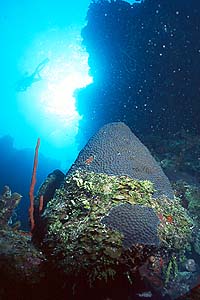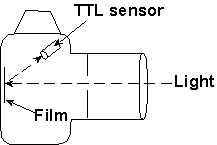Basic Strobe UseWhen you shoot pictures under water, you will almost certainly use a strobe. The basic problem is one you encountered in your first scuba course: water selectively filters out light, starting with red and working its way up the spectrum. The deeper you go, the worse the problem gets. Near the surface, you can shoot with just the camera, and there will be enough light and color to give you satisfactory pictures. But if you go deeper, the water will eat up the red light, and then the yellow and orange. Your pictures will come out looking bluer and bluer. Also, there will be less and less light, so you will use longer shutter speeds and wider apertures than you might like. The solution for this is to use a strobe. Strobes are little pieces of the sun you take under water with you. Basically they're very very bright lights--but the light comes out in a blast, and doesn't last very long. Often you will find strobes calibrated in "watt-seconds." For instance, Ikelite makes a strobe called the SubStrobe 100a, which is a 100 watt-second strobe. That means that the strobe puts out the same amount of light as a 100-watt light bulb puts out over a one-second period. But the SS-100a does it in ~3 milliseconds. In other words, the 100a is actually over 300 times brighter than the 100-watt bulb--but it's on for less than 1/300th the time! When purchasing a strobe, beware of model numbers. Take Ikelite's SubStrobe 200 as an example. The 200 in the model number refers to the fact that the strobe is a 200 watt-second strobe. But beware: as far as I know, Ikelite is the only manufacturer that follows this numbering scheme. Sea & Sea, for instance, has a strobe called the YS-120. You'd think that it was a 120 watt-second strobe...but in fact its actual power is more like 85 watt-seconds! Be sure to get the numbers on a strobe before you buy it. Also be sure to look at the coverage angle of the strobe. This number tells you how quickly the light beam spreads. For wide-angle lenses (24mm and below), you need a wide-angle strobe, with a large angular coverage. For longer lenses (35mm, 50, 60, 80, etc.), you don't want to waste all that light, so a smaller-angle strobe might be more appropriate. If you're only going to buy one strobe, buy a wide strobe so you can use it with all of your lenses. Anyway, back to using strobes. The purpose of taking a strobe with you is two-fold. The first one is just to bring some light down with you. The second is the bring some daylight down with you, in terms of the color. You've probably shined an underwater flashlight at some coral and seen how the coral appears to be a different color. Well, the strobe has the same effect. The nice daylight-colored light the strobe brings down with it only reaches about 5 or 6 feet. Much beyond that, and the water will eat up the strobe's red light, just like it did the sun's red light. So when using a strobe, be sure you're within 5 or 6 feet of your subject, or you might as well turn off the strobe. OK, so you have a strobe.You've aimed it properly. You're within 5 feet of your subject. What do you do now? Aiming your strobe
The first thing to do is learn how to aim your strobe. This is a really critical thing to learn, for several reasons. The first reason is that you want the strobe to be effective; pointing it away from your subject it not going to help! The next reason, and a truly important one, is that improperly-aimed strobes often cause an effect called backscatter. Backscatter is when light from your strobe gets reflected directly into the lens by particles suspended in the water column between your lens and your subject. Backscatter shows up in your pictures as a white snow, or sometimes as diffuse rings of lighter-colored water. Either way, you don't want it, and in most cases it is easily avoided. I don't want to go into specifics on how to aim strobes, because each type of underwater photography has it's own technique for strobe positioning and aiming. However, it is a safe generalization to say that you rarely, if ever, want to point your strobe directly at your subject, and you almost always want the strobe to be positioned as far away from your camera lens as possible. Check the sections on wide-angle photography, macro photography, fish portraits, etc. for specific details on how to position the strobe for those types of pictures. TTL Strobe ControlThe next thing you have to worry about is how much light the strobe is going to put out. What if you have a 100 watt-second strobe, and the situation only requires 50 watt-seconds of light? If you have a TTL strobe and a TTL camera, you might just be off the hook.
What is TTL? "Through The Lens." Most modern cameras have a TTL strobe control system. What it does is this: it looks at the light coming from the scene, decides when there's enough light, and then tells the strobe to quit pumping out more light (technically, the camera tells the strobe to "quench" the output). It does this by having a little light sensor in the body of the camera, in front of the film (but above, or to the side, so it doesn't interfere with the light falling on the film), that points backward, towards the film. Some of the light falling on the film will be reflected towards the sensor; the camera measures the amount of light reflected off of the film and decides from this (and your film speed, which the camera needs to know) when enough light has fallen on the film. The camera doesn't need to know the shutter speed or the aperture, because it measures how much light the film actually saw, independent of everything else. Sounds great, doesn't it? But there are problems with TTL strobe control. We'll get to them in a minute. First, let's finish off the basics of how to use TTL strobe control. All you have to do is set your strobe to 'TTL', connect it to the camera, set the camera's shutter speed to a range acceptable for strobe use (1/60 and 1/90 are common settings), and blast away. Modern cameras have a light in the viewfinder to tell you that the strobe is ready to go. This "ready light" is usually a red lightning bolt or something similar. When the ready light is on, your camera and strobe both know about each other, and are ready to work together. Release the shutter, and you're using the strobe! If everything goes right, two things will happen. (1) your film will be exposed properly, and (2) the camera will quench the strobe before it uses up all of its rated power (i.e. before our 100 w-s strobe pumped out all 100 w-s). Why is that second one important? Because the strobe can only pump out as much power as it's rated to do; then it has to recharge ("recycle" is the proper term) before you can use it again. If the camera quenches the strobe before it runs out of light, you know you had enough light (or at least the camera thought so). If the strobe ran out early, you might have gotten enough light, but probably not. In this case, most modern strobes will emit a beeping sound while they recycle, to tell you that they did a "full dump" before they quenched. Also, your camera may blink its strobe ready light to tell you the same thing. Either way, you probably did not get a good exposure. When TTL FailsTTL sounds great, but it has some problems. First off, you have to know that the TTL strobe sensor inside your camera is not very smart. All it knows is how much light it saw. It doesn't really know if the light came from the strobe hitting the subject, ambient light hitting the background, or some wayward fish swimming through your field of view. The sensor has to average all of the light it sees over whatever area it's looking at on the film. As long as everything is "average," that works great. But if your background is very bright, the sensor will cut off your strobe too early because the background will fool the sensor into thinking there was enough strobe light. Then you'll get a flat, colorless subject on an evenly-lit background. On the other hand, if the background is very dark, the sensor may let the strobe run too long, and then you'll get a overly bright subject on a dark background Believe it or not, it gets worse. Remember, the sensor only knows that the film needs 'x' amount of light to be properly exposed. But what does 'properly exposed' mean? The sensor is calibrated to give the right amount of light for subjects that are "18% gray." In other words, the sensor has to assume some average brightness, and go from there. So what? If you take a picture of a white sheet of paper, should the paper in the final image be white? Of course it should be white! What about a picture of a lump of coal. Should it be black? Of course it should be black! The problem is, the sensor will try to make both of them "18% gray." Why "18%" ? Because that's the average "reflectivity" of the world around us. If you shoot a picture of a piece of paper, that's way off of the average. Same for the coal. What does this have to do with underwater photography? Well, most of the underwater world is NOT 18% gray. This is especially true when you think about all the blue water that might be in your picture. You can shine a strobe into that stuff forever, and all you'll get for your trouble is backscatter. The problem is, the camera and its TTL strobe sensor don't know this. So if you use your strobe in TTL mode when there's a lot of blue water in the frame, you're in for trouble. Basically, here's a rule of thumb: if your subject fills more than 50% of the frame, there's a chance that TTL will work. Less than that, probably not. It gets worse when you use wide angle lenses (i.e lenses shorter than 25mm or so). If you're shooting macro, TTL is probably going to work, unless your subject is floating in open water. If it's a nudibranch crawling on something, you're in good shape. So should you just skip TTL strobe control altogether? No, especially if you're a new photographer. Initially, just blast away and see what happens. Sometimes the TTL system will get it right, sometimes not. Again, if you're shooting fish portraits or macro work, TTL is likely going to work just fine. My advice: while you're learning to do underwater photography, stick to those two types of photography, at least until you have the basics under control. But what do you do if you're in a situation where TTL strobe control is not likely to work? That's the subject of the next section: Advanced Strobe Use. |
About | UW Photos | Scuba Picture Uv the Day | Flower Gardens | Aquashot | Trip Reports | RSDiver | Photo Instruction | News | Desktop/Screensaver Images | Site Map |
||

